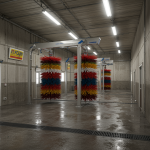- Pros of an in-house bus wash:
- Can save money over time compared to ongoing outsourcing costs
- Helps maintain bus fleets and can extend vehicle life
- Offers convenience and more control over cleaning schedules
- Modern systems can be environmentally friendly and reduce water consumption
- Cons of an in-house bus wash:
- Requires significant initial investment and facility space
- Ongoing operational and maintenance costs must be considered
- Staff training and infrastructure updates are necessary
- Best for:
- Large or mid-sized districts with many buses
- Districts in areas with harsh weather or heavy road salt use
- Districts with long-term plans for growing or maintaining their fleet
- May not make sense for:
- Small districts with just a few buses
- Districts that already have affordable, reliable third-party wash options nearby
- Bottom line: Weigh current spending against the total cost of ownership, available space, and your district’s long-term goals before deciding.
A clean school bus is more than just a matter of appearance. It reflects a school district’s commitment to safety, maintenance, and community pride. As transportation directors and facility managers weigh their budgets, a significant question often arises: is it better to build an in-house bus wash facility or continue outsourcing the service?
The decision involves a careful balance of upfront costs, long-term savings, and operational efficiency. Let’s explore the pros and cons to help your district determine the right path forward.
The Advantages of an In-House Bus Wash
Owning and operating a bus wash system can offer substantial benefits that go beyond a simple clean.
1. Long-Term Cost Savings
While the initial investment can be significant, an in-house system often pays for itself over time. Outsourcing cleaning services involves continuous, recurring costs that add up year after year. By bringing the process in-house, you convert a perpetual operational expense into a one-time capital investment with predictable maintenance costs. Over the lifespan of the equipment, a district can realize considerable savings.
2. Improved Maintenance and Fleet Longevity
Regular, thorough cleaning is a cornerstone of preventative maintenance. An on-site wash makes it easy to keep buses free from corrosive materials like road salt, dirt, and grime that accelerate rust and wear. A consistently clean fleet allows maintenance staff to spot potential issues like oil leaks, tire damage, or structural problems more easily during inspections. This proactive approach helps extend the life of your vehicles and reduces unexpected repair costs.
3. Unmatched Convenience and Control
With a bus wash on your property, you control the schedule. There’s no need to transport buses to an off-site location, which saves fuel, driver time, and logistical headaches. Your team can wash vehicles as needed—whether it’s after a muddy field trip or during a quick turnaround between routes. This flexibility ensures your fleet can maintain a high standard of cleanliness consistently.
4. Environmental Benefits
Modern bus wash systems are designed with sustainability in mind. Many feature advanced water reclamation technology that can recycle up to 80% of the water used in each wash. This dramatically reduces water consumption compared to manual washing or using older commercial facilities. You can also control the types of detergents used, opting for eco-friendly solutions that minimize your environmental impact.
The Challenges of an In-House Bus Wash
Despite the clear benefits, investing in a bus wash isn’t the right choice for every district.
1. Significant Initial Investment
The primary hurdle is the upfront cost. Purchasing and installing an automated wash system, along with the necessary site preparation and construction, can require a substantial capital outlay. For smaller districts or those with tight budgets, this initial expense may be prohibitive.
2. Ongoing Operational and Maintenance Costs
An in-house system comes with its own set of operating expenses. These include costs for water, electricity, detergents, and routine maintenance. Staff must also be trained to operate the equipment safely and perform daily upkeep. While generally lower than outsourcing fees in the long run, these costs need to be factored into the annual transportation budget.
3. Space and Infrastructure Requirements
A bus wash facility requires dedicated space. Districts with limited property may struggle to find a suitable location. The installation also involves significant infrastructure considerations, including plumbing, electrical connections, and proper drainage to comply with local environmental regulations.
When Does an In-House Wash Make Sense?
An in-house bus wash is often most beneficial for:
- Large to Mid-Sized Districts: Districts with larger fleets will see a faster return on investment due to the high volume of washes. The more buses you have, the more you save on outsourcing fees.
- Districts in Harsh Climates: In regions with heavy snowfall and salted roads, frequent washing is essential to prevent corrosion. The convenience of an on-site system makes it easier to maintain a rigorous cleaning schedule during winter months.
- Districts with Long-Term Fleet Plans: If your district plans to maintain and expand its fleet over the next decade or more, the long-term savings and maintenance benefits make a compelling case for an in-house system.
Conversely, a smaller district with only a handful of buses or a district with easy access to an affordable and reliable third-party wash service might find that outsourcing remains the more practical option.
Making an Informed Decision
Deciding whether to invest in a bus wash requires a thorough analysis of your district’s specific needs. Start by calculating your current annual spending on washing your fleet, including driver time and fuel for transportation. Compare this to the projected total cost of ownership for an in-house system, factoring in the initial purchase, installation, and ongoing operational expenses.
Ultimately, the right choice aligns with your budget, operational capacity, and long-term strategic goals. A well-maintained fleet is a safe and reliable one, and an in-house bus wash can be a powerful tool in achieving that standard.




